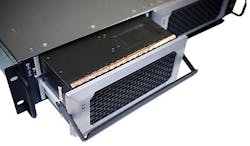Fibre Channel RAID data storage for military and avionics applications introduced by Phoenix
ORANGE, Calif., 29 Oct. 2012. Phoenix International Systems Inc. in Orange, Calif., is introducing the mission-oriented RPC24 high performance Fibre Channel RAID data storage subsystem for military and avionics applications.
Featuring a capacity of 24 drives, the RPC24 includes two removable magazines containing as many as 12 solid-state drive or hard disk drives, each housed in rugged 2U enclosure that measures 3.5 inches high by 19.5 inches deep. It provides as many as eight host ports of 8-gigabit Fibre Channel to SAS or SATA devices over a 12-gigabit SAS internal bus.
The RPC24’s rugged, cableless, backplane-based, high density operates in temperatures from -20 to 70 degrees Celsius at altitudes as high as 45,000 feet with solid-state drives.
Incorporating aluminum and steel in its rugged construction, the RPC24 weighs 51 pounds with 24 solid-state drives, is less than 20 inches deep and is certified to military specifications MIL-STD-810G and MIL-STD-461E.
Major features of the RPC24 Fibre Channel RAID Storage System include 2U ruggedized Fibre Channel RAID system; two 12 drive removable magazines rated at 10,000 mating cycles; single or dual active with auto failover/failback RAID controllers; as many as eight 8-gigabit-per-second Fibre Channel ports; sustained data rates to 5.2 gigabyte-per-second reads and 3-gigabyte-per-second writes; battery free cache backup;; 40 to 440 Hz, 90/240 volts AC input operation; redundant, hot-swap components; and management graphic user interface and failover software.
For more information contact Phoenix International online at www.phenxint.com.

